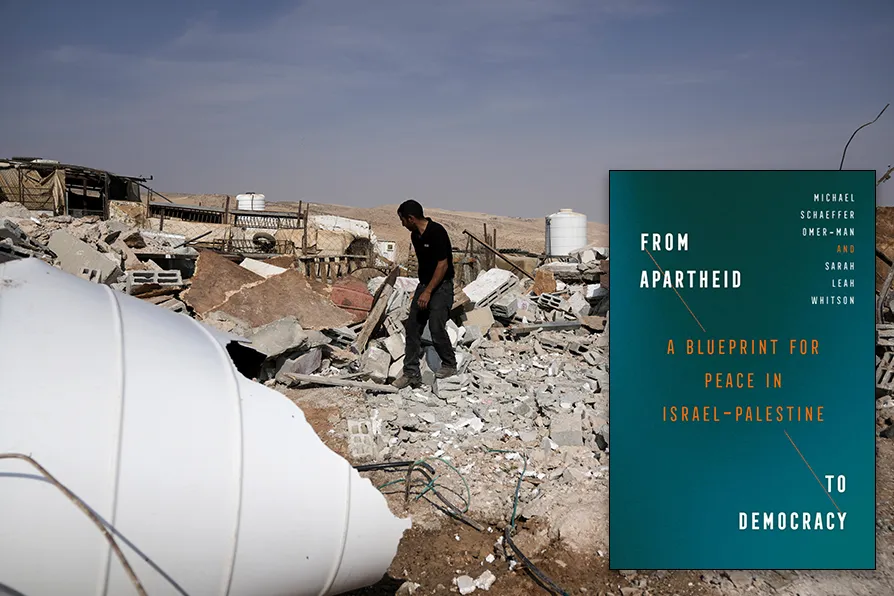MICHAL BONCZA, ANGUS REID and MARIA DUARTE review Alpha, Park Avenue, The Running Man, and Left Handed Girl
ALEX HALL recommends a considered and clear approach to dismantling apartheid and occupation, were Israel to come to its senses

 HOW CAN SUCH APARTHEID END? Samir Hamamdeh inspects the rubble of his home after it was demolished by Israeli authorities in the West Bank village of Masafer Yatta, November 12, 2025. [Pic: AP Photo/Mahmoud Illean]
HOW CAN SUCH APARTHEID END? Samir Hamamdeh inspects the rubble of his home after it was demolished by Israeli authorities in the West Bank village of Masafer Yatta, November 12, 2025. [Pic: AP Photo/Mahmoud Illean]
From Apartheid to Democracy: A Blueprint for Peace in Israel-Palestine
Michael Schaeffer Omer-Man and Sarah Leah Whitson, University of California Press, £23
ONE of the reasons left parties sometimes steer clear of prescribing a desired outcome, or solution, to Israel and Palestine is on account the fact that only the Palestinians have their own right of self-determination. It is up to them, and them alone, to determine what sort of polity they want to bring into existence.
Some follow the UN position which feebly endorses a two-state solution; others insist on one state with equal rights for all. Other voices sometimes insist that, given its incontrovertible crimes, the state of Israel itself must be dismantled.
Much of this ignores and, indeed, is discombobulated by the material reality: Israel is the only regime which “controls the entire area between the Jordan River and the Mediterranean Sea.” Palestine controls neither its borders, nor the population registry of its own citizens, has limited powers to enter into agreements with other countries, is unable to protect its own population, and most certainly does not have a monopoly on the use of violence.
This Blueprint then, is predicated on the notion that Israel has realised that its own broad ambitions – which variously include territorial expansion, expulsion of the Palestinians, a single ethnostate, regional dominance and impenetrable security – are not realistic or sustainable. Israeli aims remain the biggest barrier to any solution, which the authors freely admit.
As events since 2023 have shown, Israel is not presently minded to alter its policy direction, and indeed has unleashed a genocide in order to achieve it. The reverberations of this will continue for decades.
But it is not inconceivable that one day another state of affairs may come to pass. And, drawing on other examples, in particular the end of apartheid South Africa, the authors suggest that “something big” might one day bring Israel to the table, or might even already be underway: catastrophe, international pressure including boycotts and sanctions, or a change in the approach of the US (again, another huge ambition) could limit the political strategies available to Israel. Notwithstanding Israel’s backers in Western governments, many countries are already changing their approach.
If this happens, then the Blueprint provides a considered and clear approach to proceeding, and begins with the dismantling of the occupation and apartheid. A timetable is proposed with what to do at what point, including appointing a transitional authority, ending military rule, and restoring freedom of movement.
The authors take a close look at the legal underpinning of apartheid and suggest that Israeli, former British Mandate, and Ottoman laws (which are still in force) should be repealed or changed. Israel’s High Court of Justice should be replaced with a High Court for the Transition. Racist laws should be revoked and the authors make specific suggestions. Citizenship should be extended to everyone in the “Territory,” military and police forces be integrated, some disbanded, and political prisoners released.
After this process elections should be held and there may be a possible referendum on whether to have one, two, or more states on the Territory. Drawing on the Good Friday Agreement, the point is not to make a final judgement on what transpires, but to set out the means of deciding that.
This summary sounds like pie in the sky. But is it? This is no mere flight of fancy: the book is well referenced and draws on huge amounts of scholarship about conflict resolution, based on successful examples. Thinking about how this might all end realistically strikes a rare note of hope not found elsewhere in recent literature on Palestine. It starts from material reality, rather than outrage and indignity against Israeli crimes.
If, one day, Israel comes to its senses, a Blueprint is ready to guide the transition.
We can but hope.

Israel’s messianic settler regime has moved beyond military containment to mass ethnic cleansing, making any two-state solution based on differential rights impossible — we must support the Palestinian demand for decolonisation, writes HUGH LANNING













